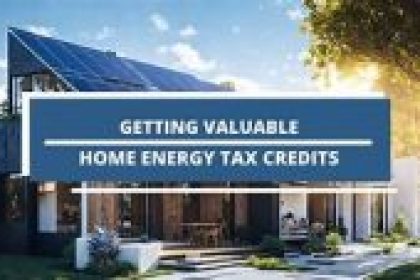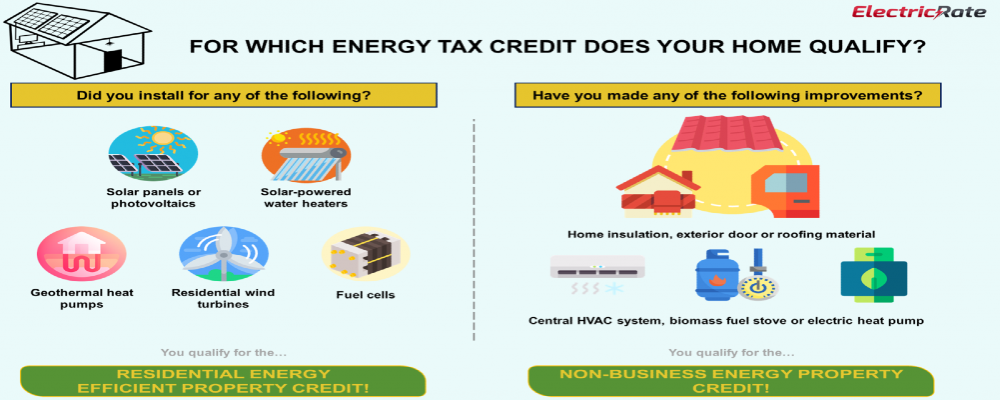
In a context of rapid growth in environmental awareness and sustainable living, homeowners and renters alike have the opportunity to make a positive impact while reaping financial benefits through energy-efficient home improvements. The U.S. government provides tax credits for qualified improvements to encourage individuals to invest in environmentally friendly upgrades. In this blog post, we’ll explore the details of the Energy Efficient Home Improvement Credit and the Residential Clean Energy Credit, providing a roadmap for those looking to improve their living spaces while contributing to a green future.
Energy Efficient Home Improvement Credit

Starting January 1st, 2023, homeowners can benefit from tax credits equal to 30% of certain qualified expenses, which cover a range of improvements. These include energy efficiency enhancements made during the year, expenses related to residential energy property, and the cost of home energy audits. It’s important to note that there are specific limits on the annual credit and on the credit amount for different types of qualified expenses. To be eligible for these credits, the qualifying property must be placed in service between January 1, 2023, and January 1, 2033. Each year, you can claim a credit of up to $1,200 for energy property costs and specific energy-efficient home improvements. There are limits for doors ($250 per door, $500 total), windows ($600), and home energy audits ($150). Additionally, you can claim up to $2,000 per year for qualified heat pumps, biomass stoves, or biomass boilers.
It’s crucial to understand that there is no lifetime dollar limit on these credits. This means that you can claim the maximum annual credit every year that you make eligible improvements until the year 2033. However, it’s essential to keep in mind that the credit is not refundable. You can receive a credit of up to the amount of taxes you owe, but any excess credit cannot be applied to future tax years. In simpler terms, these tax credits provide a financial incentive for homeowners to make energy-efficient improvements to their homes. The credits are applicable each year, allowing individuals to recoup a percentage of their expenses on qualified upgrades. However, it’s important to remember that the credits are non-refundable, meaning you can claim them up to the amount of taxes you owe, but any extra credit cannot be carried over to future tax years.
To claim the credit, the home must be located at United States, anything you spent on has to be your existing home, not a new home. All credits are aimed to your primary residence, primary residence is the place you lived the majority of the year, if you own a home but you don’t live there, you can’t claim any tax credits. If you use your primary residence for business purpose, then situation is varied. You can get full credit if business up to 20%; if more than 20%, credit based on share of expenses allocable to non-business use.
Qualified Expenses and Credit Amounts
What is the qualified expense? Any qualified home improvements expense must be new systems and materials, not used. Life span must last at least 5 years.
Building Envelope Components:
Must have an expected life span of 5 years.
- Exterior doors that meet applicable Energy Star requirements. Credit is limited to $250 per door and $500 total.
- Exterior windows and skylights that meet Energy Star Most Efficient certification requirements. Credit is limited to $600 total.
- Insulation and air sealing materials or systems that meet International Energy Conservation Code (IECC) standards in effect at the start of the year 2 years before installation. For example, materials or systems installed in 2025 must meet the IECC standard in effect on Jan. 1, 2023. These items don’t have a specific credit limit, other than the maximum credit limit of $1,200.
- Labor cost for installing don’t qualify the credits.
Home Energy Audits
A home energy audit for your main home may qualify for a tax credit of up to $150.
- Include a written report and inspection that identifies the most significant and cost-effective energy efficiency improvements with respect to the home, including an estimate of the energy and cost savings with respect to such improvement, and
- Be conducted and prepared by a home energy auditor.
Residential Energy Property
Residential energy property that meets the Consortium for Energy Efficiency (CEE) highest efficiency tier, not including any advanced tier, in effect at the beginning of the year when the property is installed qualifies for a credit up to $600 per item. Costs may include labor for installation.
- Central air conditioners
- Natural gas, propane, or oil water heaters
- Natural gas, propane, or oil furnaces and hot water boilers
- Costs of electrical components needed to support residential energy property, including panelboards, sub-panelboards, branch circuits, and feeders, also qualify for the credit if they meet the National Electric Code and have a capacity of 200 amps or more. There is a limit of $600 per item.
Heat Pumps and Biomass Stoves and Boilers
Heat pumps and biomass stoves and boilers with a thermal efficiency rating of at least 75% qualify for a credit up to $2,000 per year. Costs may include labor for installation.
- Electric or natural gas heat pumps
- Electric or natural gas heat pump water heaters
- Biomass stoves and boilers
To claim this tax credit, file the Form 5695, Residential energy Credits Part II, you must claim the tax credit for the tax year when the property is installed to your home, not just purchased.
Residential Clean Energy Credit

The Residential Clean Energy Credit offers a 30% incentive on the costs of new, qualified clean energy property for your home. This credit is applicable to installations made anytime from 2022 through 2032. However, it’s important to note that the credit percentage gradually decreases to 26% for property placed in service in 2033 and further down to 22% for property placed in service in 2034. To qualify for this credit, you need to have made energy-saving improvements to your home located in the United States. Unlike a refundable credit, the Residential Clean Energy Credit is nonrefundable, meaning the credit amount you receive cannot exceed the amount you owe in taxes. However, any excess unused credit can be carried forward and applied to reduce the tax you owe in future years.
There’s no annual or lifetime dollar limit for this credit, except for specific credit limits related to fuel cell property. This means you can claim the annual credit each year you install eligible property until the credit starts to phase out in 2033. It’s essential to keep in mind that interest paid, including loan origination fees, should not be included in the calculations for this credit. In summary, the Residential Clean Energy Credit provides a significant incentive for homeowners making environmentally friendly upgrades to their homes, allowing them to receive a credit on their taxes for eligible installations until the credit begins to phase out in 2033. You may claim the residential clean energy credit for improvements to your main home or primary residential, whether you own the home or rent it.
Your main home has to be the place where you live at most of the year. The credits apply to either new or existing home located in the United States, you can’t claim it if you are the landlord or owner of the home but you don’t live there. You may be able to claim a credit for certain improvements made to a second home located in the United States that you live in part-time and don’t rent to others. You can’t claim a credit for fuel cell property for a second home or for a home that is not located in the United States. If you use your primary residence for business purpose, then situation is varied. You can get full credit if business up to 20%; if more than 20%, credit based on share of expenses allocable to non-business use.
Qualified Expenses
Understanding qualified expenses for the Residential Clean Energy Credit is crucial for homeowners seeking to benefit from this incentive. Similar to the Energy Efficient Home Improvement Credit, it’s essential to note that all clean energy property must be brand new, not previously owned or used. Qualified expenses encompass various elements, including labor costs for the onsite preparation, assembly, or initial installation of the property. Additionally, expenses related to piping or wiring to connect the property to your home are considered eligible. However, it’s important to be mindful of exclusions. Traditional building components that primarily serve a roofing or structural function generally do not qualify for the credit. Examples of such components include roof trusses and traditional shingles that support solar panels. On the flip side, items like solar roofing tiles and solar shingles are considered qualified expenses because they actively generate clean energy. In summary, when contemplating qualified expenses for the Residential Clean Energy Credit, focus on new, energy-producing components, and be aware of the distinction between traditional building elements and those designed specifically to generate clean energy. This clarity ensures that homeowners can make informed decisions when seeking to leverage the benefits of this environmentally conscious incentive.
- Solar electric panels
- Solar water heaters
- Wind turbines
- Geothermal heat pumps
- Fuel cells
- Battery storage technology (beginning in 2023)
Qualified Clean Energy Property
-
- Solar water heaters must be certified by the Solar Rating Certification Corporation, or a comparable entity endorsed by your state.
- Geothermal heat pumps must meet Energy Star requirements in effect at the time of purchase.
- Battery storage technology must have a capacity of at least 3 kilowatt hours.
To claim this tax credit, file the Form 5695, Residential energy Credits, you must claim the tax credit for the tax year when the property is installed to your home, not just purchased.

In conclusion, the Energy Efficient Home Improvement Credit and Residential Clean Energy Credit offer homeowners and renters a compelling opportunity to contribute to environmental sustainability while reaping financial benefits. By incentivizing energy-efficient upgrades, the U.S. government aims to foster a greener future. The detailed breakdown of qualified expenses, eligibility criteria, and claiming processes provided in this blog serves as a valuable guide for individuals navigating the realm of eco-friendly home improvements. As we embark on a path towards responsible living, these tax credits become powerful tools, encouraging us to make informed choices that not only enhance the efficiency and comfort of our homes but also align with the broader goal of creating a more sustainable and resilient world. As you embark on your journey to improve your living space, consider the lasting impact these credits can have, both on your personal finances and our collective environmental well-being.
Please let us know if you have questions concerning nonbusiness energy credits or any other tax compliance or planning issues, we can be reached at (480) 980-3977!




